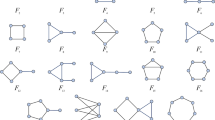Abstract
Networks are frequently studied algebraically through matrices. In this work, we show that networks may be studied in a more abstract level using results from the theory of matroids by establishing connections to networks by decomposition results of matroids. First, we present the implications of the decomposition of regular matroids to networks and related classes of matrices, and secondly we show that strongly unimodular matrices are closed under k-sums for \(k=1,2\) implying a decomposition into highly connected network-representing blocks, which are also shown to have a special structure.

Similar content being viewed by others
References
Conforti, M., Rao, M.R.: Structural properties and recognition of restricted and strongly unimodular matrices. Math. Program. 38, 17–27 (1987)
Crama, Y., Hammer, P.L., Ibaraki, T.: Strong unimodularity for matrices and hypergraphs. Discret. Appl. Math. 15, 221–239 (1986)
Crama, Y., Loebl, M., Poljac, S.: A decomposition of strongly unimodular matrices into incidence matrices of digraphs. Discret. Math. 102, 143–147 (1992)
Diestel, R.: Graph Theory. Springer, Berlin (2005)
Easley, D., Kleinberg, J.: Networks, Crowds and Markets: Reasoning for a Highly Connected World. Cambridge University Press, Cambridge (2010)
Jackson, M.O.: Social and Economic Networks. Princeton University Press, Princeton (2010)
Loebl, M., Poljac, S.: A hierarchy of totally unimodular matrices. Discret. Math. 76, 241–246 (1989)
Nemhauser, G.L., Wolsey, L.A.: Integer and Combinatorial Optimization. Wiley, Oxford (1988)
Newman, M.J.: Networks: An Introduction. Oxford University Press, Oxford (2010)
Oxley, J.: Matroid Theory. Oxford University Press, Oxford (2006)
Pitsoulis, L., Papalamprou, K., Appa, G., Kotnyek, B.: On the representability of totally unimodular matrices on bidirected graphs. Discret. Math. 309, 5024–5042 (2009)
Schrijver, A.: Theory of Linear and Integer Programming. Wiley, Oxford (1986)
Seymour, P.D.: Decomposition of regular matroids. J. Comb. Theory Ser. B 28, 305–359 (1980)
Seymour, P.D.: Matroid Minors. Handbook of Combinatorics, vol. 1, pp. 527–550. Elsevier, Amsterdam (1980)
van Steen, M.: Graph Theory and Complex Networks: An Introduction. Maarten van Steen, Amsterdam (2010)
Truemper, K.: Matroid Decomposition. Leibniz, 1998
Acknowledgments
Work of the second author was conducted at National Research University Higher School of Economics and supported by RSF Grant 14-41-00039.
Author information
Authors and Affiliations
Corresponding author
Rights and permissions
About this article
Cite this article
Papalamprou, K., Pitsoulis, L. k-Sum decomposition of strongly unimodular matrices. Optim Lett 11, 407–418 (2017). https://doi.org/10.1007/s11590-015-0975-3
Received:
Accepted:
Published:
Issue Date:
DOI: https://doi.org/10.1007/s11590-015-0975-3



